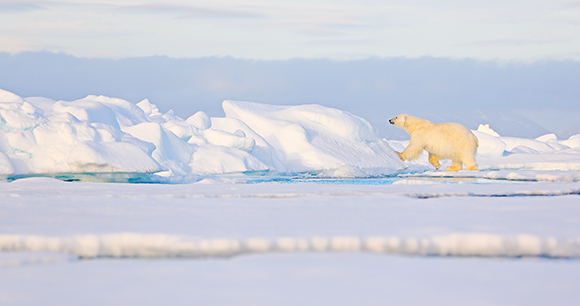by Andrew L. Von Duyke, North Slope Borough Department of Wildlife Management; Jennifer Adams and Lisette Waits, University of Idaho; Justin Crawford and Lori Quakenbush, Alaska Department of Fish and Game
The Arctic is warming faster than anywhere on Earth, and polar bears—listed as “threatened” under the Endangered Species Act—are at risk due to decreasing sea ice habitat. Monitoring polar bear populations is important for their conservation and management, but is also challenging because they occupy vast, remote, and extreme regions. With the loss of sea ice, conventional monitoring methods (including expensive aerial overflights) are becoming less reliable. Some of these methods are also invasive (e.g., physical capture, chemical immobilization, and satellite collaring), which has been of concern to local Indigenous communities, conservationists, and researchers.

An emerging field with great potential to monitor populations while also addressing some of the aforementioned challenges is the analysis of genetic material (DNA) shed by animals into their environment (e-DNA). Though e-DNA has long been applied to species detection, its use in population monitoring is trickier because it requires the identification of individuals and their sex. Thus, earlier analytical results of e-DNA in snow have been limited to detection of species presence.
A Christine Stevens Wildlife Award from AWI supported our efforts to determine polar bear individual identity and sex using e-DNA in snow and to assess e-DNA as a potential new tool for non-invasively monitoring polar bear populations. We also wanted to better understand which factors (e.g., environmental variables, field and lab protocols) affected the success rate of e-DNA extraction, amplification, and lab analysis. Our intent was to use this information to guide our efforts at further refining this method in the hope that it could become a useful tool for understanding polar bear population biology.
To collect e-DNA from wild polar bears in northern Alaska, we sampled the upper layer of snow (~1 cm) from their footprints. The snow was thawed and filtered to capture DNA—in the form of epidermal cells shed from the bear’s foot pads—for genetic analysis. Our initial efforts demonstrated that identifying polar bears was plausible. Further incremental refinements suggested that the number of footprints sampled and their relative “freshness” were good predictors of e-DNA yield and the potential for individual genotyping. After a pause in fieldwork due to the COVID-19 pandemic, we resumed our efforts in 2021, and our data again verified the presence of polar bear e-DNA at concentrations amenable to further genetic analysis. To date, we have successfully determined the identity and sex of 16 individual polar bears. On average, our genotyping success rate is equivalent to other non-invasive methods (e.g., hair DNA, fecal DNA). Building upon these results, our current efforts are focused on maximizing efficiency and applying this new tool to addressing important conservation and management questions for polar bears in northern Alaska.
Our results provide the first evidence that e-DNA collected from footprints in snow can be used to identify individual wild polar bears and their sex.1 Consequently, this method has potential as a useful, non-invasive tool for biologists to genetically monitor polar bear populations as well as other species that occupy remote, challenging, snow-covered regions.
1. Von Duyke AL, Crawford JA, Quakenbush L, Adams JR, and Waits LP (2023) Determination of polar bear (Ursus maritimus) individual genotype and sex based on DNA extracted from paw-prints in snow. Frontiers in Conservation Science. IN PRESS